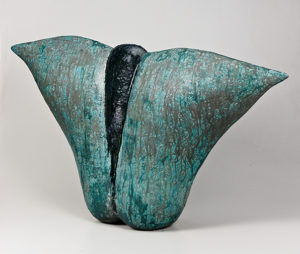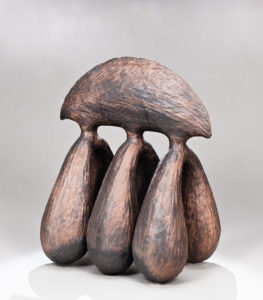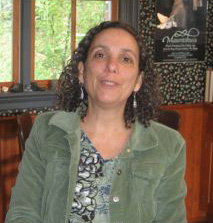Metropolitan Museum of Art Exhibit Includes Two Works by Allegheny College Professor Emerita Amara Geffen
To her delight and that of the Allegheny College community, artist Amara Geffen has two works on exhibit through August 29, 2021, in the Metropolitan Museum of Art in New York City. Upon completion of the exhibit, the works will become part of the permanent collection at The Met.
Two ceramic sculptures by Geffen, who is the Eila V. Bush Endowed Professor of Art Emerita, are part of the “Shapes From Out of Nowhere: Ceramics From the Robert A. Ellison Jr. Collection.” Ellison, an abstract painter who became a noted collector of American ceramics, gifted 127 pottery works to the Metropolitan Museum of Art, and about 80 of those pieces are currently on display. Included are Potemata and Arkhaokurios, ceramic works by Geffen.

“My work in clay — and other sculptural materials such as bronze, steel, object transformations, and installations — paid homage to sculptors like Brancusi, Louise Bourgeois, and others who explored abstraction and the ineffable through sculptural form,” says Geffen. “Both Potemata and Arkhaokurios fall into that genre. My use of abstraction and forms that suggested the energies and forces that animate life aligned with my love of, and concern for, the environment and our treatment of our planet and the more-than-human realms.”
The New York Times review of the exhibition says, “plenty of ceramists continue to work beyond its borders,” and Geffen believes that observation applies to her work.

“Although I no longer focus my work on a solo studio art practice, I continue to work beyond traditional ‘borders’ in my work as an environmental- and community-focused public artist,” she says.
Geffen’s ceramics became part of the Ellison collection in the 1990s. Following a sabbatical in 1990, during which Geffen was a resident at the Archie Bray Foundation for the Ceramic Arts in Montana, her work was featured in American Ceramics (Volume 9 Number 4, 1991). The article, “A New Body Language,” by Charlotte Wellman, was seen by Ellison, who later contacted Geffen about arranging a studio visit, which occurred in 1993.
“Following that visit, Bob selected several of my sculptures to be included in the Orga-morphic Ceramics Show he curated for the Foster-Goldstrom Gallery in New York City in 1994. He also purchased a few of the sculptures that were included in that show, and two of those were included in his recent gift to The Met,” says Geffen.
In terms of ceramics, there have historically been two traditions — functional and sculptural — that are generally seen as being distinct from one another, says Geffen. In the 1950s, potters like Peter Voulkos began to explore “modernist ideas” such as abstract expressionism in clay, moving to larger scales and away from questions unique to functional wares, Geffen explains.
“These new works required handbuilt techniques and emphasized sculptural or painterly ideas and strategies. What was significant for many ceramicists at that time was the direct application of ‘art world’ ideas in clay. Many ceramic artists contributed to this and have continued to do so over the past 70-plus years,” she says.

As a student and emerging artist, Geffen says she was far more influenced by and drawn to contemporary and historical sculptors and painters. But, despite her experience as a production potter in the mid-1970s, she “didn’t buy into the ‘art world’ bias that clay was not a valid medium for ‘serious’ artists, an unfortunate bias that has yet to be fully eradicated, which is why Bob’s gift to The Met is so important,” she says.
Geffen says her work began to shift from ceramics to more explicitly ecologically focused, community-based public art in the early 2000s. “The ideas were persistent and contiguous — that is, elevating the natural life world and calling attention to environmental urgencies, the need to protect Earth and the more-than-human realms that we humans too often overlook or disregard in the wake of our own anthropocentrism — but my materials and art-strategies changed,” she says.
Geffen is currently working on The Arc Community Greenspace at the site of the old Meadville Club on Market Street. The project will include greenspace, a performance stage for live concerts and outdoor theatre, and a series of public murals that will be visible from the Arch Street gateway into Meadville. It is being designed as a community site that will foster inclusion by providing opportunities for residents, including those receiving social services through The Arc of Crawford County, to gather for arts, culture, and wellness events. She is also responsible for the well-known “Read Between the Signs” relief that features Allegheny’s historic Bentley Hall and greets visitors transiting along Route 322.
She is also co-editing a book, Ecoart in Action: Activities, Case Studies, and Provocations for Classrooms and Communities, which will be available for purchase in January/February 2022. Compiled from 67 members of the Ecoart Network, a group of more than 200 internationally established practitioners, Ecoart in Action will be a field guide that offers practical solutions to critical environmental challenges, according to its publisher, New Village Press. The book will be organized into three sections — Activities, Case Studies, and Provocations — each artist’s contribution provides models for ecoart practice that are adaptable for use within a variety of classrooms, communities, and contexts. (Watch this video to learn more about Geffen’s work and the book.)
Geffen earned her Bachelor of Fine Arts from the University of Cincinnati and her Master of Fine Arts from Indiana University. She joined the Allegheny faculty in 1982 and taught at the College until 2018, when she was awarded emerita status. She was named the Eila V. Bush Endowed Professor of Art in 2016 and continues to hold that title. In 1997, Geffen developed the Art & Environment Initiative, a community-focused, public, and environmental art program, which engaged Allegheny students in local projects from its inception through to Geffen’s retirement. She has completed more than 17 community-based projects that serve as tools for placemaking and community development through creative reuse, art, and community collaboration. To learn more, visit her website at www.amarageffenstudios.com.
When asked if she has any advice for art students, Geffen advises: “Show up to your work each and every day, and learn to listen to your own voice. Follow your instincts. Doing the work is key. It is, after all, what artists do. We are makers, organizers, communicators, connectors, meaning-makers, and truth tellers.”